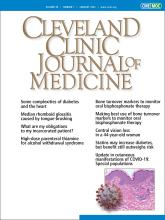Table of Contents
From the Editor
- Some complexities of diabetes and the heart
Patients with diabetes are at greater risk of coronary artery disease than their peers without diabetes. That’s straight and simple. But there the simplicity ends.
The Clinical Picture
- Median rhomboid glossitis caused by tongue-brushing
The patient had started vigorous brushing 1 month earlier after being told that she had bad breath.
1-Minute Consult
- What are my obligations to my incarcerated patient?
A court order authorizes a blood transfusion, but the incarcerated patient refuses the transfusion. As the caregiver, am I obligated to follow the court order against the patient’s wishes?
- Which patients hospitalized with alcohol withdrawal syndrome should receive high-dose parenteral thiamine?
The authors briefly outline risk factors for Wernicke encephalopathy and when high-dose parenteral thiamine is indicated.
Review
- Bone turnover markers to monitor oral bisphosphonate therapy
Rapid changes in levels of bone turnover markers can be useful in monitoring the effectiveness of therapy and improving adherence to therapy.
Editorial
- Making best use of bone turnover markers to monitor oral bisphosphonate therapy
Clinical applications of bone turnover markers can include determining when to start or end a bisphosphonate “holiday” and measuring treatment response.
Symptoms to Diagnosis
- Central vision loss in a 44-year-old woman
The patient had a wide range of symptoms and comorbidities, resulting in a complicated differential diagnosis. Careful evaluation eventually led to a focus on sexually transmitted infection.
Review
- Update in cutaneous manifestations of COVID-19: Special populations
Recognition of skin reactions and their implications is beneficial to clinicians in shaping patient counseling and anticipatory guidance. An illustrated guide.
- Statins may increase diabetes, but benefit still outweighs risk
The weight of the evidence suggests that statin use is associated with an increased risk of new-onset diabetes mellitus, but the magnitude of the effect has varied across studies.




